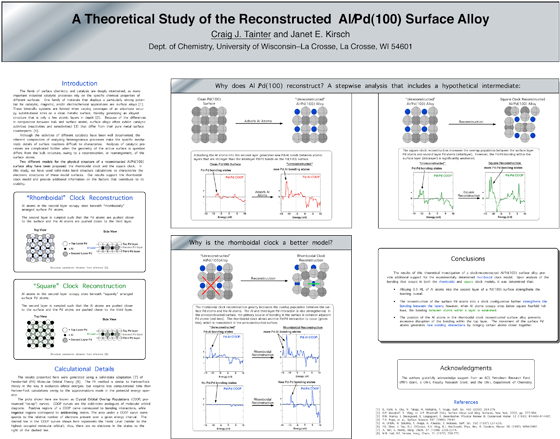
Electronic Structure of Surface Alloys
Janet E. Kirsch, PhDDepartment of Chemistry, University of Wisconsin-La Crosse
Electronic Structure Studies of a Clock-Reconstructed Surface Alloy
Janet E. Kirsch, PhDDepartment of Chemistry, University of Wisconsin-La CrosseSurface alloys, pure metals that have an alloyed structure in their top few atomic layers, have a particularly strong potential for catalytic, magnetic, and/or electrochemical applications. Because of the differences between bulk and surface atoms, these alloys often exhibit catalytic properties different from those of pure metal. Janet Kirsch and her research team are applying computational chemistry in order to understand why certain alloys undergo a reconstruction of their surface structures.
While many people use physics to study surface reconstructions, Dr. Kirsch’s work focuses on the chemical bonding that takes place in these alloys. Specifically, Kirsch studies the electronic structure factors that cause a reconstruction in a Pd(100) surface alloyed with aluminum atoms. This particular alloy has numerous applications in practical catalytic processes. It also undergoes the specific type of surface atom reconstruction known as the “clock” reconstruction.

One of the most important properties of any computational chemical method is its ability to identify the most likely atomic structure of the system under study. Two different models for the physical structure of a reconstructed surface alloy have been proposed: the rhomboidal clock and the square clock. Kirsch’s analysis used solid-state band structure calculations to characterize the electronic structures of the model surfaces; accordingly, it provides support for the rhomboidal clock model.
Kirsch’s team has made additional discoveries regarding bonding strength and bonding interactions of the alloy. The position of the Al atoms in the rhomboidal clock reconstructed alloy prevents excessive disruption of the bonding within the top layer. The movement of the surface Pd atoms generates new bonding interactions by bringing certain atoms closer together. According to Dr. Kirsch, “If we can understand more about the way different catalysts work, then we have the opportunity to learn how to make these catalysts more selective. We can learn how to optimize a catalyst and how to make one more durable.”
Dr. Kirsch credits the PRF grant with getting her research off the ground. “It really helped me become a better principle investigator. The grant has helped me become a better leader of my students.” While only one undergraduate student was directly funded through this research, all of Kirsch’s students have benefited from the opportunity to use the equipment purchased through the grant and to learn about advanced topics in computational chemistry in her teaching curriculum.




